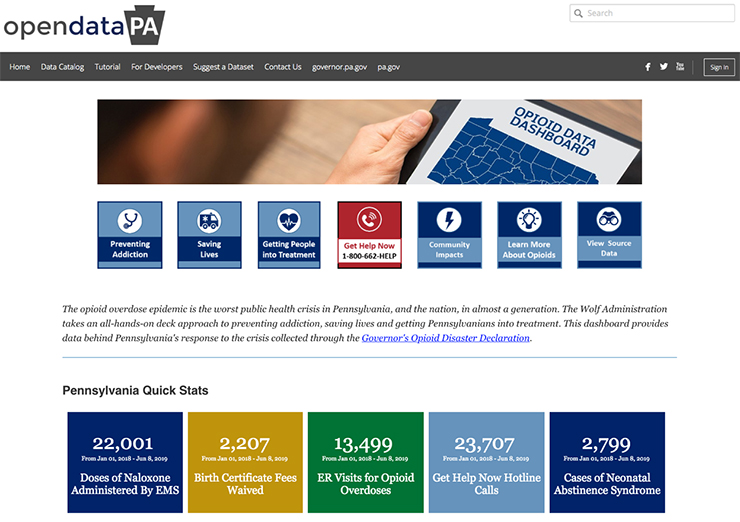'We're Trying to Save Lives'
August 05, 2019 by Melissa Crowe

Photo credit: Ajay Suresh/Flickr
Over the past five years, the number of daily opioid-related deaths in the U.S. have increased more than three-times.
That’s according to details from the National Institute of Drug Abuse, which shows the death count has risen to 130 a day versus 50 a day in 2014.
Pennsylvania is among the states hardest struck by the epidemic.
“Everyone in Pennsylvania knows someone who knows someone who overdosed,” says Kimberly Early, LSW, policy director at the Pennsylvania Department of Health.
In response to the epidemic, Governor Wolf issued a 90-day disaster declaration in January of 2018, which continues to be renewed every 90 days. The disaster declaration created an Opioid Command Center, led by the Department of Health and Pennsylvania Emergency Management Agency, that brings together over 17 agencies in the Commonwealth to create a coordinated response to the epidemic. One of the initiatives of the Command Center was the launch of the Opioid Data Dashboard in March 2018.
Recently, the Pennsylvania Department of Health launched the next iteration of its Opioid Data Dashboard via the state’s open data portal, which is powered by Socrata. The public dashboard shares data on four areas: preventing addiction; saving lives; getting people into treatment; and community impacts. The expanded dashboard brought the addition of the community impacts page, which aims to evaluate the effect of the opioid epidemic on several areas, including the impact on other opioid related diseases, families and children, the economy, and the criminal justice system.

“This is an effort to fight the stigma and educate the public on the scope of the opioid epidemic,” Early says. "In sharing this, you see it impacts nearly every Pennsylvanian.”
Data-sharing was crucial to building the dashboard. The team leveraged existing state data either as part of the disaster declaration or in normal lines of business and pulled in federal data, such as data on Medicare-funded treatment centers.
“It required a lot of collaboration between multiple agencies in the state,” says Carolyn Byrnes, MPH, special advisor to the Secretary of Health. “We are fortunate have Gov. Tom Wolf’s leadership and the command center that already brings together agencies. It’s a natural collaboration.”
The dashboard is a comprehensive tool that:
- Offers responders across the state new evidence to make key decisions to best change the trajectory of the opioid epidemic;
- Serves as a cross-sector bridge from experts across academia, the public and private sectors, and government agencies to provide contextualized data; and
- Better facilitates a collaborative response to the opioid crisis in Pennsylvania and save more lives.
The data has supported discussions in potential policy initiatives among the collaborating agencies, including the Departments of Health, Human Services, and Drug and Alcohol Programs.
“Those metrics are the underlying of everything we do each week,” Byrnes said. “We point to areas of commonalities between the efforts going on among the 17 agencies. Sometimes they function in silos, but by showing the bigger picture we can illustrate how this coordinated response is impacting the epidemic.”
The expanded dashboard is funded through the generosity of the Aetna Foundation and created in collaboration with the University of Pittsburgh Graduate School of Public Health.
Byrnes said the expanded dashboard is created with sustainability in mind. When the funding is up in June 2020, the team will have a plan in place to ensure that data will continue to be updated so insights stay current.
“We’re ensuring in the future that the data is up-to-date,” Byrnes said.
As increasingly, more governments release data publicly about the opioid epidemic in their jurisdictions, April Hutcheson, spokeswoman for the Pennsylvania Department of Health, says the key is to consider not just having the data, but using it to impact change.
“Putting it out there is great, but you need to use it,” she says. “We use it to help guide decisions to look for weaknesses and gaps in our services. Information for the sake of information is great, but what are you going to do to implement change?”
More than an awareness campaign, the dashboard’s goal is to drive people to action — whether that’s checking into a treatment facility or knowing where to get access to naloxone.
“We’re trying to save lives,” Hutcheson says.
The Pennsylvania Opioid Data Dashboard is supported by the Aetna Foundation, a national foundation based in Hartford, Connecticut, that supports projects to promote wellness, health, and access to high-quality health care for everyone. The views presented here are those of the author and not necessarily those of the Aetna Foundation, its directors, officers, or staff.